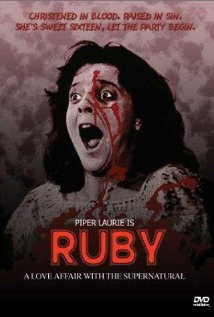The title of this film and Piper Laurie’s presence clearly derive from CARRIE (1976) – though I was misled into thinking that Ruby was the possessed child rather than the mother. While I’m not sure the EXORCIST trappings were really necessary, these actually extend to only a couple of scenes…and one has to understand that the notorious ‘spider walk’ from the 1973 classic – depicted here (but more on this later) – wasn’t officially a part of the film until its 2000 re-edit! Incidentally, the irate-father-speaking/murdering-through-his-child angle was also seen in Mario Bava’s contemporaneous SHOCK (1977).
RUBY, therefore, is silly but quite effective scene-by-scene and, anyway, it certainly provides a unique mixture of supernatural horror with the typical gangland milieu. The drive-in theater element (showing ATTACK OF THE 50-FOOT WOMAN [1958] years before it was actually made; the story is ostensibly set in 1951!), then, renders the proceedings even trashier (especially with the participation of a sluttish habitué) – while, at the same time, serving as a comment on the genre itself.
The swamp (and period) setting supply the requisite atmosphere: Laurie’s bitter but still-attractive torch singer/aspiring film-star/gangster’s moll dominates her associates (the very same gang that killed her lover at the start of the picture!) but obviously clings to the past – linking the film to Harrington’s earlier horror outing WHAT’S THE MATTER WITH HELEN? (1971). The odd-looking Janit Baldwin is perfectly cast as the mediumistic girl, especially creepy when the dead gangster – through her – confronts Laurie with his suspicions that the latter set him up. Stuart Whitman is a likable ageing hero, and Roger Davis rises to the occasion as a paranormal expert.
Unfortunately, the special effects and gore are cheaply done and the ending (different from Harrington’s original conception) somewhat abrupt; though the version on the VCI DVD I purchased is credited as being the “Director’s Cut”, it’s still missing some footage…but, at least, is free of other additions requested by the producers (reportedly the work of Stephanie Rothman) for the film’s Network TV showings.
The disc includes an hour-long career overview with director Harrington and film critic David Del Valle, which is extremely interesting: it touches upon some of the films I watched in tribute to his recent passing, but also a number of others (including the TV stuff) which are still very rare to come by. Besides, he fondly reminisces about his encounters with several film legends such as Alfred Hitchcock, Josef von Sternberg, Orson Welles and James Whale (let’s not forget that Harrington is the man responsible for saving the latter’s delightful THE OLD DARK HOUSE [1932] from oblivion) – all of whom, incidentally, are among my own personal favorites!
The Audio Commentary is similar to the one for Harrington’s NIGHT TIDE in that, apart from denoting locations where specific scenes were shot (which would mean very little to a foreigner like myself!), the director seems to be fuzzy on many production details. However, what he didn’t forget – or forgive, for that matter – is his strained relationship with the film’s executive producer, Steve Krantz (whom Harrington even describes as “evil”): he never misses an opportunity to put him down – berating Krantz for his stinginess, for imposing a mediocre cameraman on him and, needless to say, for ruining his ‘poetic’ ending! The director also remarks about the remarkable longevity of horror classics vis-a’-vis mainstream productions from Hollywood’s Golden Age, and recalls the Karloff/Lugosi vehicle THE RAVEN (1935) as having been his introduction to the genre. Incidentally, the RUBY Commentary is a lot more animated than that of NIGHT TIDE – thanks to the enthusiastic contribution of star Piper Laurie, even if she’s critical of her own performance at this juncture (and blames the tight schedule for it). As for the ‘spider walk’, it emerges that this eerie contortionist effect wasn’t borrowed from THE EXORCIST at all – but rather from a Salvador Dali painting about a psycho-physiological condition known as the Hysterical Arch!

